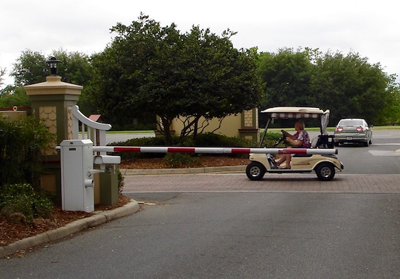The Gates are Widening
The Evolution in Geography and Vehicle Types
What the title of this month’s article means is established gated communities, such as The Villages in Florida, are, in fact, growing, and secondly, that the small vehicles used in these communities are becoming less recognizable as golf cars and much more understood as individualized, personal transportation vehicles.
These two changes are certainly well-recognized, but what is not so well appreciated at this point is the fact these trends are a component of a much broader evolutionary process toward new transportation systems, which will involve new types of small vehicles, serving the needs of urban mobility and personal mobility.
Urban mobility: Is it relevant to the gated community?
You may be saying to yourself, “What do we, in our gated community—which we purposely chose to get away from the mayhem and dysfunction of cities and suburbs—have to do with urban and personal mobility?” Good question. (As an aside, being a commuter on occasion into New York City, I often ask myself, “How do you spell dysfunction?” And the spelling I come up with is “N-e-w Y-o-r-k”.)
The answer to your question is this: New technologies and new products constantly create and find new markets. Do you question the need for your cell phone now, even though, perhaps, a decade or so ago you might have said to yourself, “What do I need a cell phone for? Landlines are just fine for me.” Any number of products now in common use, especially in the field of electronics, were, at their inception simply replacing products serving the same basic functions. These new products were easier to use, allowed more options, and were faster and otherwise more efficient—and for the greater benefits offered, less costly.
Current signs and benefits of the brave new world of urban and personal mobility
Significant benchmarks of the coming urban and personal mobility transformation and new product lines would be, but are not limited to, the following:
- Lithium batteries, providing maintenance-free long life, potentially eliminating range anxiety;
- Faster charging allowed by lithium and significantly improving opportunity charging;
- Mobility as a service (MaaS), an individualized transportation service, supplanting vehicle ownership;
- Permanent magnet electric motors for greater power and greater efficiency;
- Improved suspensions;
- More automotive features, particularly for the interior.
Onward 2-passenger, coming with lithium
These items have added over time to product lines and models, with lithium power being, perhaps the most important factor. The popular Club Car Onward, pictured here, is due to follow the Tempo line of fleet vehicles and transporters with lithium batteries. (The announcement is expected shortly.)
E-Z-GO broke ground last year with lithium in its Elite line of vehicles. It’s not clear why the company has not equipped its stylish 2-Five PTV with lithium. Perhaps it’s safety concerns with lithium batteries in the hands of individual owners, rather than under the supervision of the golf course fleet. But does the market want it? Go to the Buggies Gone Wild forum, and you will all manner of interest in converting the 2-Five and other PTVs to lithium.
Trojan Battery’s Trillium lithium battery
For that matter, you can contact ReLion Battery or Trojan Battery and get a drop-in lithium battery equipped with the electronics for use with your current charger. (Both companies will supply you with specific instructions regarding a conversion from lead acid.)
Bridging to the urban/suburban small vehicle market
The various improvements in the current PTV market, which promise significant advances in performance are the building-blocks along the way to a transportation system characterized by electric power, mobility as a service (MaaS), self-driving technology, vehicle and environmental interconnectivity, 5G level data transmission, and, with autonomous vehicles, a completely redesigned interior emphasizing new types of functionality while getting from point A to point B.
All these characteristics, which are synergistically interconnected, could easily warrant several descriptive paragraphs, but the assigned space for this article is insufficient to do this. So, what will probably grab most of the attention is the element of self-driving, or autonomous vehicle (AV) technology. If you have followed events in the AV space at all, you may be aware of Waymo, the autonomous vehicle technology company. Funded by Google and operating as a division of Google’ parent company, Alphabet, Waymo is now in active testing mode as a commercial transportation company in Phoenix, AZ. Neighboring State of California has begun instituting similar projects.
A hypothetical Waymo Autonomous Vehicle
The Waymo vehicle pictured is simply a hypothetical small vehicle in which the autonomous driving system in installed. Waymo is not necessarily manufacturing the vehicles in which their systems could operate. The picture is chosen because it illustrates what could be likened to an enclosed PTV. Other small vehicle companies specifically addressing urban mobility have been cited in previous articles, such as the Uniti from Sweden and the Baro One from the U.K.
In a stock analyst’s report from Jefferies, the author, Rebecca Ungarino, cites another report from UBS in which UBS auto analyst Colin Langan wrote, “…that even though Waymo had just launched its commercial autonomous car service outside of Phoenix, Arizona, the MIT professors that the firm met with believe it will be a decade before scale AV applications in complex urban environments become commonplace.”
Note the key words: “decade” and “complex urban environments” and “commonplace”. Substitute the words “2-3 years”, “gated communities”, and …yes, commonplace. That is the prospect for AVs in less complex environments, including our gated communities across the country.
It’s up to the consumer
What you say? No way, I love to drive my PTV. OK, noted, but some within the community might prefer to have hands free to indulge in texting, reading a Kindle book, taking Aunt Hattie’s urgent call reminding you to be sure to feed her dog, and maybe even streaming an NFL football game.
Along with AV will come the likelihood of radically different vehicle interiors, once the need for driver controls is eliminated. For example, seats and retractable tables designed to be office-functional. All sorts of possibilities. Maybe even a hot tub. Might be stretching a bit, but you get the point.
Contact the Author: Steve Metzger at smetzger@smallvehicleresource.com. Or check out our website at www.smallvehicleresource.com, where you will find an extensive database of vehicle models and can make side-by-side comparisons of vehicles based on a full set of specifications.



